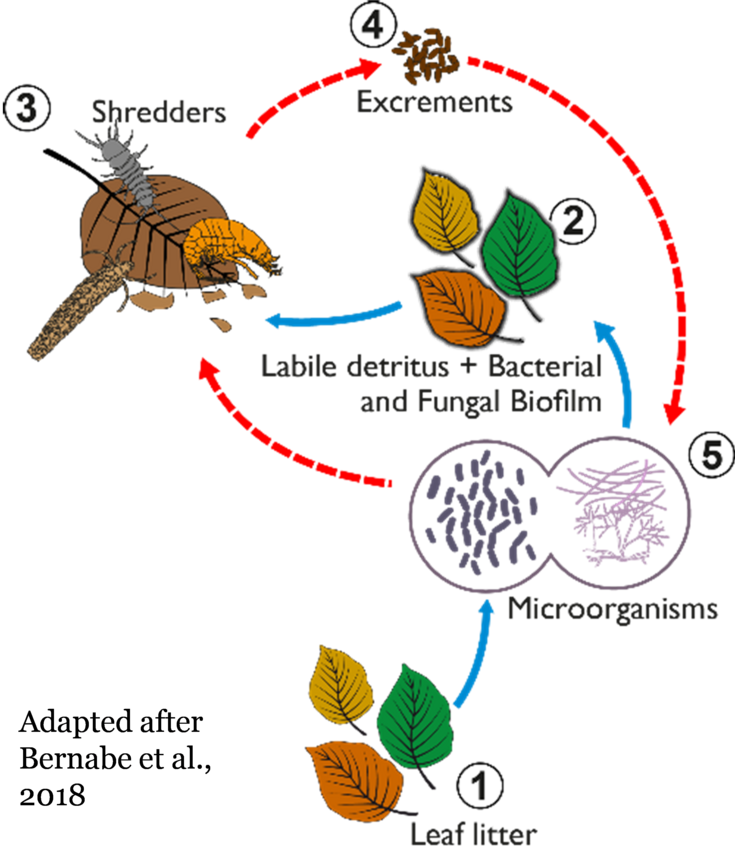Exploring Biodiversity-Ecosystem Functioning Relationships of Leaf Litter Decomposition in Streams
Supervisor: Wolfram GRAF
Project Assigned to: Mourine YEGON
Freshwater ecosystems are regarded as of critical importance for human societies through their provision of ecosystem services, yet they are among the most threatened habitats and experience a disproportionate loss of biodiversity - twice as much as terrestrial or marine habitats (Tickner et al., 2020; He et al., 2019; Darwall et al., 2018). This is because these ecosystems integrate the effects of land use, wastewater disposal and/or habitat modification that reduce biodiversity of a diverse range of biota, including plants, fishes, aquatic invertebrates and vertebrates, as well as microorganisms such as algae, fungi and bacteria. At the same time, stream ecosystems act as a connectivity zone of aquatic-terrestrial interfaces and transport energy and materials, including sediments and nutrients, as well as terrigenous organic materials such as leaf litter. Here, organic materials and leaf litter are processed and upcycled by the stream biota, and fed back into the food web.

Leaf litter processing is an essential ecosystem function in forested stream ecosystems, which are considered net-heterotrophic systems: much of the carbon and nutrients channelled through their food webs come from the surrounding terrestrial ecosystems (Santonja et al., 2018; Marks, 2019). Macroinvertebrate shredders serve important roles in leaf litter decomposition in streams. Through their detritivorous activities, shredders release fine particles such as leaf fragments and faeces, which are used in the aquatic food web by microbes (that colonize faeces and Fine Particulate Organic Matter (FPOM)) and by invertebrate collectors (relying on FPOM as food source). Through mastication, shredders also provide additional nutrients and habitats for microbes while serving as food for predators themselves (Santonja et al., 2018).
The linkage between leaf-litter and macroinvertebrate shredder detritivores is pivotal and critical in stream ecosystem; these aquatic fauna are shown to quantitatively contribute up to 63.5% of total leaf litter mass loss in streams (Boyero et al., 2021; Taylor & Chauvet, 2014). Leaf litter processing as an aspect of ecosystem functioning in freshwater systems is however being modified by the effects of anthropogenic stressors as leaf litter decomposition can be simultaneously affected by diversities in plant matter, microbial decomposition and invertebrate detritivores—all of which are subject to global change.
This PhD seeks to explore biodiversity-ecosystem functioning relationships in streams by focusing on the importance of both resource (leaf litter) diversity and benthic invertebrate fauna (shredder) diversity on nutrient and carbon cycling in streams. This will be done by conducting laboratory experiments with variable litter diversity and shredder diversity to study the effects on production of fine particulate organic matter (FPOM) and decomposition of coarse particulate organic matter (CPOM). The study will follow two experimental lines: (1) varying leaf litter diversity and (2) varying shredder invertebrate diversity. In both cases, the Particulate Organic Matter (POM) uptake and production will be investigated through the leaf mass loss, rate and quantity of (FPOM) generation as well as the biomass gained by the detritivore shredders. The chemical properties of the POM (C:P, C:N ratios) will also be analysed. POM pathways will be tracked through the food web structure using stable isotope technology to assess their uptake efficiency and fate.
The PhD most strongly relates to the research clusters “connectivity” and “metabolism” of the doctoral school Human River Systems in the 21st Century (HR21); which aims to understand the complex “ecosystem interactions“ in an aquatic system, the “physical, chemical, and biological processes” influenced by alterations in riverine ecosystems and how they affect biodiversity in it.
Boyero, L., López-Rojo, N., Tonin, A. M., Pérez, J., Correa-Araneda, F., Pearson, R. G., ... & Yule, C. M. (2021). Impacts of detritivore diversity loss on instream decomposition are greatest in the tropics. Nature communications, 12(1), 1-11.
Darwall, W., Bremerich, V., De Wever, A., Dell, A. I., Freyhof, J., Gessner, M. O., ... & Weyl, O. (2018). The Alliance for Freshwater Life: A global call to unite efforts for freshwater biodiversity science and conservation. Aquatic Conservation: Marine and Freshwater Ecosystems, 28(4), 1015-1022.
He, F., Zarfl, C., Bremerich, V., David, J. N., Hogan, Z., Kalinkat, G., ... & Jähnig, S. C. (2019). The global decline of freshwater megafauna. Global Change Biology, 25(11), 3883- 3892.
Marks, J. C. (2019). Revisiting the fates of dead leaves that fall into streams. Annual Review of Ecology, Evolution, and Systematics, 50, 547-568.
Santonja, M., Pellan, L., & Piscart, C. (2018). Macroinvertebrate identity mediates the effects of litter quality and microbial conditioning on leaf litter recycling in temperate streams. Ecology and evolution, 8(5), 2542-2553.
Taylor, B. R., & Chauvet, E. E. (2014). Relative influence of shredders and fungi on leaf litter decomposition along a river altitudinal gradient. Hydrobiologia, 721(1), 239-250.
Tickner, D., Opperman, J. J., Abell, R., Acreman, M., Arthington, A. H., Bunn, S. E., ... & Young, L. (2020). Bending the curve of global freshwater biodiversity loss: an emergency recovery plan. BioScience, 70(4), 330-342
